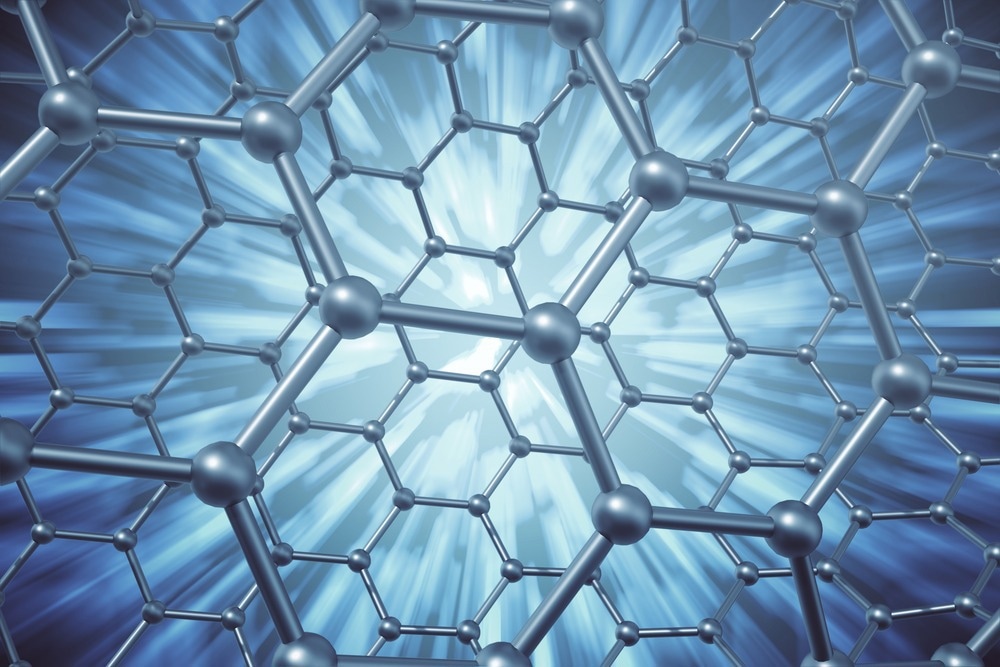Portable electronic devices raised the demand for supercapacitors with high power density and mechanical flexibility within a finite area. However, currently commercialized devices come with in-plane interdigital configuration and thickness-confined sandwich design, limiting their mechanical features.

Study: Spatial-Interleaving Graphene Supercapacitor with High Area Energy Density and Mechanical Flexibility. Image Credit: Rost9/Shutterstock.com
In the present study published in the journal ACS Nano, a spatial-interleaving (SI) graphene supercapacitor was constructed. Here, graphene microelectrodes were stacked as multiple layers in a three-dimensional (3D) space. Moreover, each microelectrode was matched with four counter microelectrodes with narrow interspaces between all 3D spatial-interleaving microelectrodes that facilitated effective ion transport in the device.
The results revealed that the SI graphene supercapacitor showed high specific areal capacitance of 36.46 millifarads per square centimeter and energy density of 5.34 microwatt-hour per square centimeter on a device of 100-micrometer thickness.
Microelectrodes in each layer were interdigitated that endowed excellent mechanical flexibility in as-constructed graphene supercapacitors and exhibited approximately 98.7% performance retention even after 104 cycles of bending tests.
The constructed SI graphene supercapacitor had integrated mechanical flexibility and high area energy density within a confined area. Hence, these SI graphene supercapacitor units have great potential in wearable devices, calculators, and light-emitting diodes (LEDs).
Graphene Supercapacitor
The development of power sources with flexible configuration and high power density is a new research interest due to the huge demand for portable and wearable electronics. The high storage capacity of supercapacitors enabled their application in modern electronics, offering short charging time, structure designability, and long cycling stability.
Traditional sandwich supercapacitors lack finite thickness and have inefficient ion exchange between electrolytes and electrodes, inducing a low power density. Although in-plane supercapacitors could increase the thickness and promote electrode material loading to achieve high area energy density, the additional electrode material loading induced mechanical rigidity.
Graphene has a large specific surface area, high electrical conductivity, superior mechanical flexibility, and outstanding electrochemical properties. Hence, carbon is replaced by graphene in supercapacitors. The surface area is critical for capacitance, and since graphite has a high surface area, it can offer better electrostatic charge storage in graphene supercapacitors.
Graphene supercapacitor has rapidly evolved from laboratory prototypes to commercial electronic devices that might compete with commercial batteries soon. The graphene supercapacitor utilizes its elastic properties, lightweight nature, and mechanical strength.
Hence, a graphene supercapacitor can store an equal amount of energy as a battery and can be recharged quickly. Moreover, graphene supercapacitor is safer and environmentally friendly than current commercialized batteries and can be operated without overheating or explosion.
Graphene Supercapacitor with High Area Energy Density and Mechanical Flexibility
In the present work, the SI graphene supercapacitor was developed with mechanical flexibility and high area energy density. In this supercapacitor, the graphene microelectrodes were stacked into multilayers within a finite 3D space. Each microelectrode was matched with four counter microelectrodes, enlarging the surface area between microelectrodes.
The 3D spatial-interleaving microelectrodes with narrow interspaces facilitated efficient ion transport in the device of 100-micrometer thickness. Moreover, the excellent mechanical flexibility of the SI graphene supercapacitor was maintained due to interdigitated microelectrodes in all the layers of graphene microelectrodes.
The results confirmed a correlation between the number of layers of graphene microelectrodes and the areal capacitance of the SI graphene supercapacitor that was absent in the capacitors designed with in-plane or sandwich configuration.
The SI graphene supercapacitor of 100-micrometer thickness exhibited a specific areal capacitance of 36.46 millifarads per square centimeter at 20 millivolts per second scan rate and energy density of 5.34 microwatt-hour per square centimeter. Moreover, about 98.7% of initial capacitance was retained under the bending state after more than 104 cycles.
The SI graphene supercapacitor unit integration into a flexible energy storage device or power electronics is a facile process. The flexible configuration and 3D spatial interleaving on graphene supercapacitors provided a good perspective for their application in portable/wearable electronics with high area power density.
Conclusion
An SI graphene supercapacitor of 100-micrometer thickness with mechanical flexibility was constructed based on the reversed stacked microelectrodes and spatial-interleaving design within a finite 3D space, wherein the capacitance linearly increased with thickness.
Moreover, due to the reversed stacked architecture, the facing area was enlarged; consequently, effective inter-microelectrode ion transport was maintained during the process of charge dissipation with enhanced Coulomb efficiency.
The constructed SI graphene supercapacitor exhibited a high specific areal capacitance of 36.46 millifarads per square centimeter at 20 millivolts per second scan rate with an energy density of 5.34 microwatt-hour per square centimeter.
Furthermore, an initial capacitance of 98.7% was retained after 104 cycles. The parallel connection or simple series of SI graphene supercapacitors delivered higher capacitance and voltage, facilitating their applications in commercial electronic devices.
Reference
Wang, L., Yao, H., Chi, F., Yan, J., Cheng, H., Li, Y., Jiang, L., Qu, L. (2022) Spatial-Interleaving Graphene Supercapacitor with High Area Energy Density and Mechanical Flexibility. ACS Nano. https://pubs.acs.org/doi/10.1021/acsnano.2c04989
Disclaimer: The views expressed here are those of the author expressed in their private capacity and do not necessarily represent the views of AZoM.com Limited T/A AZoNetwork the owner and operator of this website. This disclaimer forms part of the Terms and conditions of use of this website.